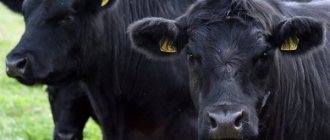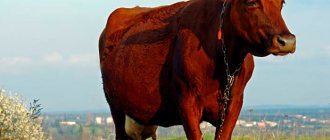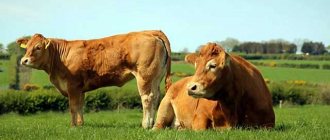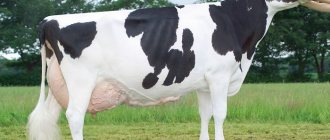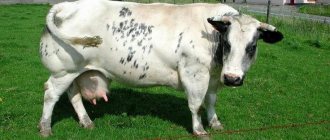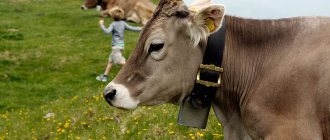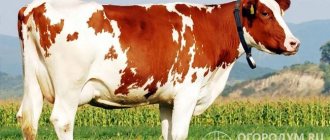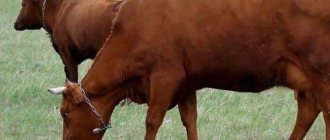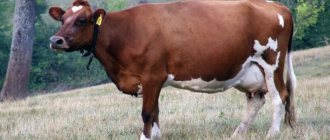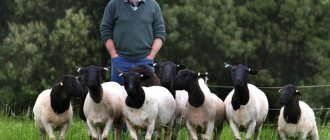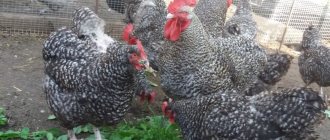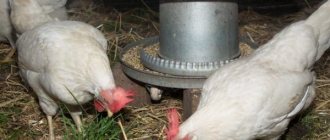Among beef cattle, one of the first places belongs to Kazakh white-headed cows. This renowned breed has been confirming its reputation for decades. Based on the existing conditions, livestock breeders often choose it for its high productivity and maintenance features, which allow them to keep livestock in the open air for most of the year. As a rule, these cows are used for meat production, but there is also a variety of Kazakh white-headed cows for meat and dairy production.
Description and characteristics of red steppe cattle
Dimensions
Bulls of the Red Steppe breed can grow up to 900 kg, and cows - up to 400-500.
Newborn calves weigh up to 40 kg, heifers up to 30 kg. By the age of six months, young animals can reach 200 kg (subject to proper feeding). The color of the animal is reddish, but the intensity of the shade can be different - from fiery red to dark cherry. Other characteristics of the breed:
- weak thin bones;
- straight strong legs;
- voluminous belly;
- deep narrow chest;
- insufficiently formed dewlap;
- thin long neck covered with folds;
- raised mane.
The red steppe cow belongs to the dairy type of productivity.
One of the best dairy breeds is the red steppe cow, bred on the territory of Ukraine in the last century.
constitution is strong and dry
Bull's initial weight
Heifer initial weight
Average milk yield on breeding farms
Average milk value by breed
early ripening, 18 months, weighing about 350 kg
high, up to four offspring in three years, every 380 days
about 700 grams per minute
As a result of growing in the steppes of Ukraine, representatives are characterized by high qualities of adaptation to any climate and living conditions. They can easily tolerate 40-degree heat and severe frosts with strong winds. They have strong immunity.
The herd survives without water for long periods of time without any problems. Moreover, during drought, the individual will maintain its weight by feeding on dried grass. The breed is recommended for cultivation in the Urals, Kazakhstan, Stavropol and Krasnodar territories, Omsk, Rostov regions.
The steppe cattle breed is distinguished by its red color. But the shades of its skin can be different - from bright red to rich burgundy, as seen in the photo of steppe cows. There are cows with white spots on the belly, legs, head, and udder.
| Part of the body | Peculiarities |
| Weight | Heifers - from 400 to 500 kg, bulls - up to 900 kg, newborn calves - from 27 to 40 kg, and by 12 months - 300 kg |
| Torso | Angular, long body, narrow back |
| Limbs | Straight, strong, but short |
| Stomach | Volume |
| Breast | Narrow, with underdeveloped dewlap |
| Neck | Thin, with many folds, has a mane |
| Udder | Small, round, sometimes irregular in structure, with irregularities, cylindrical nipples |
| Horns | Light gray in color, dark at the ends, directed forward |
| Spine | Sturdy but lightweight |
| Head | Small, graceful |
| Height | Medium, 128 cm |
It is interesting that in the struggle for primacy, the red steppe cow can injure and even kill its rival with its horns. Therefore, farmers should be aware of this feature and carry out the procedure of dehorning cattle at an early age.
The productivity of burenka is determined by various factors, including the region in which it is grown. On average, about 4 tons of milk are produced per year. But you can achieve 5 tons with special feeding and care.
The fat content of dairy products is low - about 3.6-3.8%. Protein content - 3.6%. The milk flow rate is from 1.8 l/min.
Over the past 50 years, several records have been registered among red steppe breeds, bred mainly at breeding farms in Kazakhstan and Ukraine:
- more than 10,000 liters per lactation - 14 cows;
- from 9,000 to 9,999 l - 32 representatives.
The following cows deserve special attention:
- Burya, grown in Ukraine, in Zaporozhye - 10,170 liters of milk with a fat content of 4%.
- Murashka from the Kherson region with a milk yield of 10,500 liters, fat content - 4%.
- Application from the Omsk region with a milk yield of 11,000 liters and a fat content of 4%.
- Cloudberries from Kazakhstan with a milk yield of 12,400 liters and a fat content of 3.8%.
Getting meat
Despite the fact that the color is dairy, sometimes cattle are sent for slaughter. The beef yield is not very large - 50%. If you raise an animal specifically for fattening, the percentage will be slightly higher - 55%. But the quality of the products is significantly inferior to other breeds, although they have a rather pleasant taste and juiciness.
There is little fat in beef, but this indicator depends on the diet of the livestock and its age. There is an opinion that animals that eat pasture in summer and hay in winter have more tasty meat.
Appearance of the Kazakh white-headed breed
The color of the individuals is dark red, with white spots on the head, belly, legs and tip of the tail. Leather and wool deserve special attention. Many folds, elasticity of the skin, well-developed subcutaneous fat make the skin in demand on the leather goods market. This feature allows livestock to gain and lose weight several times a year, and thick subcutaneous fat (for an individual weighing 300 kg is 36 kg) to easily survive even the harshest winters.
The wool of the Kazakh white-headed breed of cows is characterized by variability - in summer it is short and normal, but in winter, after molting, it becomes not only long and thick, but curls in places.
The shape of the body is barrel-shaped, large. The muscles are powerfully developed, the chest protrudes forward strongly, this is especially noticeable in bulls. The legs are predominantly short, which allows them to carry such mass over uneven terrain. Strong legs plus powerful muscles provide good stability to individuals.
Appearance of the Kazakh white-headed breed of cows
Description of the Kazakh white-headed breed:
- high productivity of meat and milk;
- precocity;
- good adaptation to weather changes from hot to cold;
- good tolerance of meager feeding;
- high quality meat products;
- solid yield after slaughter.
Distinctive external features
Kazakh white-headed breed of cows, external characteristics:
- Small head, strong body, of medium height (the height of a cow at the withers is 125±5 cm, bulls are slightly higher).
- Barrel-shaped body, chest depth - up to 70 cm, chest volume reaches 190 cm, and the distance between the shoulder blades - up to 45 cm.
- Strong, straight spine.
- Powerful, slightly humped neck.
- Massive bone, oblique carcass size up to 155 cm
- Short white legs, leg circumference 20 cm.
Conditions for keeping cows
Loose Contents
Free-stall housing technology is considered optimal for breeding beef cows and has the lowest cost. It consists of raising cows on pastures with the installation of sheds or using lightweight premises. In this case, the calves stay together with the uterus on suction. The first option involves arranging a 40 cm thick bedding under a canopy. When livestock begins to compact the bedding and contaminate it with feces, biological processes within the straw are activated and heat is released. This helps animals avoid hypothermia in winter. In the cold season, the bedding is not changed, but new straw is gradually added at the rate of 1–3 kg per adult.
Livestock in easier conditions
- low costs for organizing conditions of detention;
- servicing the livestock does not take much time;
- Keeping calves and cows together has a beneficial effect on the health of young animals and reduces the cost of feeding them.
The free-stall method of keeping cattle is considered appropriate for large farms where the herd size exceeds 400 animals. In this article you will learn the features and disadvantages of this method of content.
Housing in barns
In the second case, when animals are kept in lightweight barns, the organization is carried out indoors. A pen for young animals is set up in the center of the building. Here the calves are accustomed to eating concentrated feed and have the opportunity to move freely. Bedding for adult cattle and suckling calves is placed around the pen around the perimeter of the room. In the summer, such livestock are kept on range or grazing. Feeders and drinking bowls are installed in the center. At the end of the barn there are isolated places for calving cows. Here they are kept with newborns until they are one week old.
Calves in the barn are accustomed to concentrated feed
Advantages of the second method:
- allows you to organize the herd depending on the season;
- solves the problem of dividing livestock according to certain criteria, which makes caring for them easier;
- allow the farmer to easily control the herd and keep records.
Kinds
Currently, farms breed two main lines of this cattle: beef and meat and dairy. The first type is the main one. In farms containing meat animals, the technique of long-term grazing on pastures is mainly practiced.
Calves on such farms are raised by suckling. In winter, livestock are fed mainly concentrates, silage and roughage.
Farms specializing in raising the Kazakh white-headed meat and dairy line use slightly different methods of caring for animals.
In this case, the calves are weaned from the uterus after some time. The selection of livestock on such farms is carried out both for meat and dairy traits.
Diseases and prevention
Like Herefords, the Kazakh Whitehead is resistant to most diseases. Diseases to which animals are more susceptible: infectious, invasive (when worms, spiders, ticks, and other parasites get into/on the body), problems with the musculoskeletal system and diseases of the genital area.
Kazakh white-headed bulls are often exposed to the following diseases: leptospirosis, fever, necrobacteriosis, eimeriosis, mastitis.
Leptospirosis is more common in cattle and humans. The disease is especially dangerous for a calving female - calving will be premature, the fetus will be born dead. For young animals, the disease can be fatal
Infection occurs through water or when sick and healthy individuals are kept together, which is why it is so important to always isolate suspicious cows for quarantine until the circumstances are clarified. Diagnosis is made based on blood and urine results
Bluetongue affects small and large livestock, especially if they graze together. The lungs, intestines, and central nervous system are affected.
Necrobacteriosis is typical for herds kept in unclean premises. The first symptoms are ulcers on the body that need to be dried and treated with an anesthetic.
Eimeriosis affects young animals. Symptoms: weakness, fever, refusal to eat, lethargy, painful diarrhea. Be sure to treat the premises with ammonia (aqueous solution) during treatment.
Mastitis affects those cows whose milking regime is disrupted - incomplete milking, draft, walking during cold rain, or congenital pathology of the udder. Treat with antibiotics, massages, local remedies (ointments, compresses).
External scratches and wounds are treated according to the situation - treatment with an antiseptic, suturing. Since animals are always free, they often scratch their sides and legs on plant thorns or fence wires.
Description of Kalmyk breed cows
Even 400 years ago, the Kalmyk breed of cows became widespread in Siberia, the Volga region and the Don banks. The main difference of this breed is longevity, endurance and strong body structure. Females and males have a crest on the back of the head - this is the main difference from other breeds. Animals were strictly selected based on utility, with the best cows selected and the worst cows discarded. Cattle were formed under the influence of harsh climate with daily pasture maintenance.
The animals are red with white spots, red, red-motley or brown-motley with crescent-shaped horns. The weight of an adult cow can reach as much as 500 kilograms, and bulls up to 1100 kilograms. A newborn calf weighs approximately 25 kilograms.
The Kalmyk breed can also be recognized by the following characteristics:
- horns resembling a crescent moon;
- the constitution is strong;
- the lower back is elongated;
- nimbleness;
- the ribs are widely spaced from each other;
- the neck is fleshy;
- the head is not heavy;
- the dewlap and chest are well formed;
- the belly is round and slightly saggy;
- visible udder;
- the withers are wide;
- the skin is quite thick;
- long hair;
- the back is straight;
- the legs are straight and massive.
This breed is often crossed with other breeds of bulls to produce new types of meat or meat-fat breeds. The Kalmyk animal has excellent genetic material. All breeds that were crossed with the Kalmyk cow inherited from it resistance to weather conditions and any climate, quickly gain weight, and graze in the pasture from morning to evening.
Povolozhsk farmers crossed Kalmyk breeds with Shortgrn and Simmental breeds to improve the quality of their cows. But even after such crossing, they realized that the pure breed still has better qualities than the crossed one.
In the Volga region in 1928, breeders, when they had 1200 heads of cattle, identified and noted such qualities as:
- adaptability to the Russian climate;
- rapid weight gain, for females 600 kilograms, and for males 1 ton;
- high percentage of slaughter meat;
- juiciness of meat.
Today, this is done by farmers who keep cows in dry steppe conditions. On strong sunny steppes, only 90% of all animals feel well. This is due to the fact that other breeds are not so adapted to such harsh climatic conditions and their productive performance decreases.
The most popular Kalmyk breed is in the following regions of Russia:
- Lower Volga region;
- Kalmykia;
- Stavropol region;
- Rostov region.
Somewhat later, they began to be bred in Kazakhstan, Turkmenistan and Uzbekistan. In these foreign regions there are no competitors for Kalmyk cows.
At home, a bull can be raised to 900 kilograms of live weight, and calves with good feeding and proper care already weigh 450 kilograms by the age of one and a half years. With proper feeding, the slaughter weight is 66%, much higher than that of other cow breeds. The slaughter weight of a one and a half year old bull is 60%. The carcass comes out weighing 200 kilograms.
Farmers often keep the Kalmyk breed of cows, since its meat is tender, there is a lot of it at slaughter, and lard also has excellent taste. They also begin to breed early, cows are good mothers, they quickly fatten up, rapidly gaining weight. Kalmyk cows and bulls calmly tolerate various weather conditions and quickly get used to the new climate.
Where can I buy
Kazakh cattle are bred and sold in breeding farms or from private owners in Kazakhstan (Kurtamysh), Russia (Samara, Volgograd, Barnaul, Biysk, Krasnodar), Belarus. Animals from the Russian nurseries “Chapaevsky”, “Red October”, “Akantinsky” are known for their quality.
Bull of the Kazakh white-headed breed
Nuances when purchasing a Kazakh white-headed
When choosing cows and bulls, you need to clarify what subtype the breed belongs to: white-headed, beef, dairy or mixed. This will allow you to obtain the output of the raw materials you need. You also need to be careful, since the Kazakh white-headed and Hereford breeds are very similar in appearance, but the Kazakh breed is more profitable.
Differences between Kazakhstani breeds:
- Herefords are more massive, 70 kg ahead of one-and-a-half-year-old Kazakh calves, and 400 kg ahead of an adult;
- the meat yield of white-headed cows and bulls of the same age is 2% greater than that of Herefords;
- slaughter of 7-month-old calves is more profitable for the Kazakh breed, and for 15-month-old calves - for the Hereford breed;
- endurance is better in animals of the Kazakh white-headed breed.
Average price of white cows
The price for young animals starts from 12 thousand rubles or from 120 rubles/kg live weight (heifers from 150).
Features of feeding
The Kazakh white-headed dog is adapted to living conditions in semi-desert territory. Cows are adapted to hot climates and calmly make long journeys over long distances in solar conditions. They easily tolerate a lack of water. When feeding on scarce steppe grasses, white-headed animals do not lose weight due to fat reserves.
Pastures are suitable for keeping livestock; it is recommended to keep animals there as long as weather conditions allow. Young animals are additionally fed with silage feed and compound feed; straw is prepared for adult livestock.
When the first grass appears, the cows are transferred to pasture land. Straw and green mass account for about 65% of the white-headed breed's total diet. The remainder is replenished with concentrates, succulent feed - root crops and silage. Mineral supplements include bone meal and tripotassium phosphate. For stud bulls, an increased share of root crops, grain mixtures is introduced, and hay, which belongs to the highest category, is given.
Content Features
The breed is generally considered economical and is suitable for beginning livestock breeders. Breeders rate the animals as unpretentious. Among the peculiarities of keeping, the freedom-loving nature of livestock is noted, which grows poorly in cramped conditions. To raise animals of this breed, a loose-stall method is used. An open walking area or a spacious room can be chosen as a place of detention.
The pen should be free of drafts and clean.
Ideal conditions are achieved using a layer of straw bedding, approximately 30 cm thick. A new layer is added daily, approximately 3 kg per animal. During the stall period, the litter will increase to about a meter, so for one individual you need to provide about 5-7 square meters. meters of area.
It is recommended to equip the walking area on the south side of the barn. To walk, one cow needs about 8 square meters. meters of area. In this case, a hard surface must be provided. If it is not there, you need to increase the area to 25 square meters. meters. It is more convenient to install feeders not inside the site, but along the edges of the entire perimeter. This artificial pasture can function all year round. In this case, it is better to leave the barn doors open, and you can close the cows only in severe frosts.
In winter, individuals can be grazed on natural pasture, but provided that there is long grass remaining. In its absence, some farmers leave windrows of mown grass in the fall and in this way solve the problem of the lack of a walking area for keeping freedom-loving cows.
The diet of Kazakh white-headed cats may consist of the following menu:
- morning: water, crushed grain, hay;
- evening: straw, crushed flour, water.
One animal relies on about 5 liters of crushed grain per day. In this case, there should be plenty of dry hay. In winter you need to add concentrates to the feed. Wheat or barley straw can be used as the main feed. The diet may contain up to 60% roughage types of food.
Cattle are considered suitable for breeding from +50 to -40 degrees. Free housing for cows combines few costs and maximum benefits for beef cattle. The entire herd, including young suckling calves, can be kept in one place under a shelter or in an open area.
Advantage of the method:
- saving;
- easy maintenance;
- good performance;
- good performance in calves.
Negative properties are the need to divide the diet according to the age groups of cattle:
- juveniles;
- adult bulls and cows;
- milking individuals.
Feeding standards for these subgroups are different and should include certain types of feed. For example, feeding young animals is distinguished:
In the first case, the calf is left with its mother for several days
Since it is important for him to receive colostrum, which lays the foundation of the immune system. The method allows young animals to gain up to 500 grams of weight per day
Accustoming to food is possible gradually, after three months of feeding with milk or after six months of such feeding. A three-month-old calf should additionally receive special vitamins.
The diet of adults consists of hay, concentrates and protein products. In the fall and winter, corn and sunflowers will be especially nutritious. The calving cow is fed beans, soybeans and zucchini.
Farmer reviews about the breed
Owners of farms specializing in breeding Kazakh white-headed cattle have a relatively good opinion about him. This cattle received good reviews primarily for:
- correct physique;
- rapid weight gain even with a fairly meager diet;
- no problems with coverage.
In terms of productivity of the Hereford breed, the Kazakh white-headed breed, in the opinion of most farmers, is unfortunately inferior. However, it is also much more adapted to the harsh conditions of the steppe zone of Russia. In addition, these cattle, unlike Hereford cattle, are not at all afraid of long drives.
The advantage of this cattle, among other things, is its undemanding quality of feed. These cows eat literally everything. If necessary, it is allowed to feed these cattle both barley and wheat straw. Approximately 60% of all roughage fed is this product.
Of course, endurance in relation to weather conditions is also one of the undoubted advantages of cows of this breed. It is believed that this cattle can be kept at temperatures from +50 to -40 degrees. And without loss of productivity.
What to feed adult livestock
The diet of white-headed cows is formed mainly based on the existing vegetation in the territory of residence. The Kazakh steppes do not pamper cattle with an abundance of fresh grass. The almost desert area has sparse steppe flora. Nevertheless, even with such nutrition, cows do not lose their weight due to a powerful fat layer. Green feed, straw and hay occupy up to 70% of the diet. The remaining share comes from concentrated feed. The meat side of the breed digests roughage well. Their share of the total number of products can be up to 45%. Cereals, silage and beets are essential products for Kazakh white-headed cows. In order for cattle to maintain the required amount of minerals in the body, they are fed with special vitamin supplements and bone meal. Stud bulls are fed generously with legumes and grains.
Approximate diet of adults
In autumn and winter, Kazakh cows are most often kept on silage feeding. It is prepared in advance from mown grass, corn shoots and sunflowers. The disadvantage of this feeding is the low percentage of sugar content in the finished product. Foods high in carbohydrates, such as beets, help compensate for its deficiency.
What to feed calves
In the first hour of a calf's life, the farmer needs to make sure that he licks the mother's udder. The resulting colostrum contains a large amount of immunoglobulin and lays the foundation for immunity in the newborn. Until the age of three months, cow's milk will be considered the main food product in the calf's diet.
Approximate diet for calves
During this time, he drinks up to 1500 kg. Accustoming young animals to the use of concentrated feed occurs gradually. The less valuable species are given first, since calves receive all the necessary substances for growth through their mother’s milk. By the end of the third month, the young animals are transferred to higher quality feed. If a bull gains 200 kg by the age of six months, it is weaned from an adult cow.
Amount of milk received
The average milk yield for 305 days of lactation ranges from 3694 kg to 4582 kg. This is above the standard requirements for beef cows. It is known that milk yields are not the same in different periods. For example, the indicators for newly calved individuals are not very high. Milk productivity is usually recorded in the middle of the milking period, which lasts about 90 days. Milk yield begins to fall after insemination.
It is easier to record the milk yield of each animal separately. The daily intake of white-headed cows is about 20 liters in the summer. The dependence of these indicators is often associated with the regional conditions of keeping cows.
For example, if the climatic zone for raising livestock is characterized by predominantly cold weather, under such conditions there is a natural decrease in milk yield. A decrease in indicators by 10-15 percent is caused by the lack of succulent feed, as well as sufficient drinking.
The protein content and fat content of milk in winter also decrease by 10-15 percent due to a decrease in green mass in the feed, but remain at the level of 3.6%, which is the standard for beef cows. You can return the indicators to normal if you provide the cows with daily walks, proper nutrition, and sufficient drinking.
The Kazakh meat breed has good taste: the meat is juicy, with a marbled layer.
Marbled beef is called when fat layers are clearly visible among the muscles. This feature is not inherent in all cattle breeds. The gain of meat per head with good feeding is about a kilogram per day.
The slaughter age for meat is 1.5 years for bulls. By this period, the individual gains up to 400 kg of weight. The yield of dairy-type meat products is somewhat less: pure meat from a carcass is about 60 percent, and the percentage of bone mass is 40 percent.
A little history
This highly productive cattle was bred back in Soviet times by breeders from Kazakhstan and the Lower Volga region. At that time, specialists used the Hereford, Kazakh and Kalmyk breeds as parent breeds. Subsequently, the individuals obtained by crossing were bred “inside”, selecting the most productive bulls and cows. The Kazakh white-headed breed was approved as an independent breed in 1951.
From Hereford cattle, representatives of this variety received such valuable qualities as high meat yield and rapid weight gain. These cattle got a powerful body from Kazakh bulls. Selection work is carried out with this breed even today. The efforts of specialists are aimed primarily at improving, of course, its meat qualities. The best breeding Kazakh white-headed cattle is concentrated today in the Volgograd region, on breeding grounds. This cattle is improved here both by renewing the blood using Herefords and by selecting the best representatives.
Productive qualities
Although the Kazakh white-headed breed was bred as a meat breed, it is considered a meat and dairy breed, and there are also its varieties (mixed, pure meat, dairy).
The productivity of this breed is impressive. For a mixed type of meat it is 2.5 tons/year.
The meat subtype is characterized by precocity and high weight gain:
- if the cow weighs more than 500 kg, then the meat yield will be 58%;
- Kazakh white-headed bull from 900 kg gives 60-70% meat;
- bone weight 14%.
Calves are born weighing up to 30 kg, gaining 1 kg/day. Bulls of the Kazakh white-headed breed reach 230±10 kg at the age of 8 months, and at 1.5 years they weigh 400 kg.
Amount of milk received
For mixed type milk productivity is 1.5 tons/year, for dairy milk – up to 2.5 tons of milk/year, there are cases when 6 tons/year were obtained with intensive feeding of cows. Milk fat content is up to 4.8% (average 3.85%). Taking into account the milk and meat received and the expenditure of funds, the minimum cash investment is obtained.
The milk fat content of Kazakh white-headed cows is up to 4.8%
Meat characteristics
The weight of bulls of the white-headed Kazakh breed is from 800 kg (maximum samples - 1.3 tons), cows - from 450 kg (maximum - 600 kg). Meat yield 60-70%. In regions where the period with lush grass lasts longer, the average cow weighs 250±50 kg more.
Advantages and disadvantages of the breed
Easy maintenance, unpretentiousness in feed, resistance to temperature changes and harsh continental climates have made the Kazakh breed of cows very popular. The owners note a number of advantages of this cattle:
- almost year-round grazing;
- extensive fattening;
- minimal costs for feed, including the winter period;
- excellent digestibility of feed, including pasture;
- independent search for food in pastures;
- good quality meat, tender and juicy;
- good health, bulls and cows rarely get sick, they have no hereditary pathologies;
- fast metabolism;
- good rate of weight gain and growth of young animals;
- excellent adaptation to both low and high temperatures;
- normal heat exchange and stable body temperature.
The disadvantages include the skeleton being too narrow for meat animals. Because of this, the Kazakh breed does not use its full potential and relatively rarely gains maximum weight.
The second drawback is that heifers take excessive care of their offspring. After calving, they are too aggressive and dangerous to approach. Many farmers note that during the selection process, the meat of the Kazakh white-headed breed began to lose its marbling, and the streaks of fat disappeared between the muscles. This somewhat reduces its value and taste.
Subtleties of breeding
The peculiarity of breeding the white-headed cattle breed is free range. By moving a lot and constantly searching for food, animals eat a variety of foods well, build muscle mass and gain weight.
Free-ranging herd
Areas favorable for breeding
Although the Kazakh white-headed breed was bred for Kazakhstan, it has taken root in various regions of Russia (Saratov, Samara, Orenburg regions, Buryat Autonomous Okrug, Altai), Mongolia, Belarus and Ukraine.
Features of calving in the Kazakh breed
Females are considered sexually mature after one and a half years, but are ready for insemination at 14 months and are capable of producing offspring up to 15 years of age. Natural fertilization is preferable, which gives 95% of successful attempts, while the artificial method gives a maximum of 80% of the result. Bulls become capable of insemination at 16 months.
During pregnancy and calving, human assistance is not needed, except perhaps enhanced nutrition. A calving cow after 285 days of pregnancy produces only one calf.
Kazakh white-headed calf
Childbirth is easy, largely due to the small skull of the newborn. Strong young animals, long-term milk feeding (up to 3 months) plus a powerful maternal instinct provide 100% survival of the offspring. A calf will need almost 1.5 tons of milk for the entire period of growing up (3 months), but breeders agree to this, since when breeding a meat breed, cows are not even milked.
Milk becomes normal a week after calving. After just a month, the females are ready for a new mating, but it is worth giving two to three months of rest so that the cow has time to recover; moreover, after fertilization, milk yield decreases.
Calves of this breed
The size and number of young animals possible from one cow varies depending on the conditions of its keeping. On average, during the 10-15 year reproductive period, one individual receives one calf annually, and for the entire period - 10-15 heads of newborn calves.
Mortality among young animals is zero. The animals are strong and have a good immune system. The ripening period is approximately three months. During this period, the calf necessarily drinks its mother's milk.
During the first hours and days of life, young animals must receive colostrum. This product contains the necessary immunoglobulin, which will become the basis for the health of the newborn.
During the growing period, a calf will consume about 1500 kg of milk. In general, in farms aimed at feeding meat animals, cows are not milked. Dairy products are used in full to feed young animals. With a normal diet, a bull gains about 200 kg by the age of six months.
Maintenance in winter
When it gets cold outside, cows need to be kept in a barn
During this period, it is important to take care of the presence of a deep bedding of straw; you need to add some hay to it. In winter, animals are kept without a leash in the barn.
The air temperature in the premises where newborn calves will be kept should not drop below +12 degrees. Adults can easily withstand lower temperatures down to -20 degrees, but this negatively affects their productivity. Recommended humidity in the barn is 65-70%.
The barn can contain both individual and herd housing. In the latter case, it is only necessary to isolate the inseminating bulls from the cows and from the calves. If there are many calves in the herd, then they are sorted into age groups: 6-9 months, 1.-1.5 years, 1.5-2 years.
In winter, the housing for calves is equipped with deep, permanent bedding. It is made from straw and sawdust. It is advisable to add a bacterial preparation to the deep litter in order to suppress pathogenic microflora and maintain beneficial fermentation processes.
Even in a pen, calves should be able to move freely, this is important for their proper development. They should also spend some time outdoors
For this purpose, special walking yards for young animals are set up.
Calves are not tied up for winter walking, and there is no need to provide drinking water. Bulls require little water; heifers require more fluid and attention. It is recommended to walk the latter only in the warm season. Movement and walking are important for cows; if this moment is provided to them, then they will calve easier and their udders will not swell.
What do farmers think?
- Anna, 38 years old. “At the beginning of my farming, I doubted whether it was worth buying a Galloway cow, would it function well with other breeds? There were a lot of questions and few answers, but I decided to take a risk! In the end, I was satisfied. I bought three females and one bull. This was 4 years ago. Now I am more focused on the Galloway color, I have 5 heifers, two bulls and three calves. Absolutely unpretentious creatures! They get sick a little, they require little food, although it is of high quality. I don’t spend too much money on their maintenance, which is why I make more profit from selling milk, meat, and the animals themselves.”
- Mikhail, 43 years old. “I don’t like this breed! I resell animals and I can say that customers are very picky about the appearance of cows. Many people don't like the white belt on the back. They say that it breaks the overall symmetry of appearance. Although I myself think differently. I can say one thing: this individual is not suitable for resale. Perhaps it is needed for the usual maintenance and sale of milk or meat. I haven’t had such experience, I can’t say for sure.”
